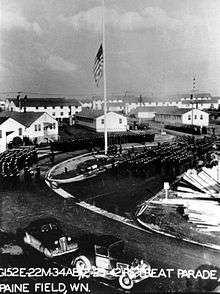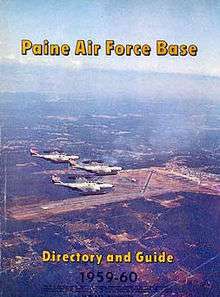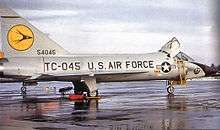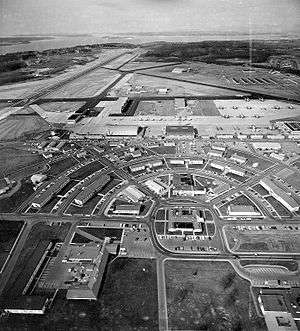Paine Air Force Base
Paine Air Force Base | |
|---|---|
| Part of Air Defense Command | |
| Located near: Everett, Washington | |
|
North looking oblique photograph of Paine AFB in the 1950s, showing the military runways and station area used by Air Defense Command | |
| Coordinates | 47°54′22″N 122°16′52″W / 47.90611°N 122.28111°W |
| Type | Air Force Base |
| Site information | |
| Controlled by | United States Air Force |
| Site history | |
| Built | 1936 |
| In use | Open 1936 – closed 1966 |
| Airfield information | |||||||||||||||||||
|---|---|---|---|---|---|---|---|---|---|---|---|---|---|---|---|---|---|---|---|
| IATA: none – ICAO: none | |||||||||||||||||||
| Summary | |||||||||||||||||||
| Elevation AMSL | 606 ft / 184.7 m | ||||||||||||||||||
| Coordinates | 47°54′22″N 122°16′52″W / 47.90611°N 122.28111°WCoordinates: 47°54′22″N 122°16′52″W / 47.90611°N 122.28111°W | ||||||||||||||||||
| Map | |||||||||||||||||||
 Location of Paine Air Force Base | |||||||||||||||||||
| Runways | |||||||||||||||||||
| |||||||||||||||||||

Paine Air Force Base is a closed United States Air Force base, approximately 6 miles southwest of Everett, Washington. It was active during World War II as a IV Fighter Command air defense field for the Seattle area and during the Cold War as an Air Defense Command interceptor base. It was closed on 30 September 1968.
History
Paine Air Force Base was originally constructed in 1936 as a Works Progress Administration project known as Snohomish County Airport. At the time of development, it was envisioned that the Airport would create jobs and economic growth in the region by becoming one of the ten new "super airports" around the country.
The large commercial airport that was planned for in the 1930s never happened. When the United States entered into World War II, there was a need to protect the large Bremerton Navy Yard and the Boeing aircraft plant and airfield in Seattle, which produced the B-17 Flying Fortress bombers. In 1940, the United States Army Air Corps leased the airport and named it Everett Army Air Field.
At that time of its acquisition in 1941, Paine Army Airfield consisted of little more than two paved runways in the common cross-section pattern, set off at different angles to take advantage of the most favorable winds. The airfield was expanded by the Air Corps to consist of a 6,300' east/west main runway and three secondary runways of 5,000' (NW/SE), 5,000' (NE/SW) and a 5,000' N/S runway. A large parking apron was constructed to accommodate the aircraft with maintenance hangars and supporting buildings. East of the airfield, a ground support station was constructed consisting of about several hundred buildings based on standardized plans and architectural drawings. The buildings were designed to be the "cheapest, temporary character with structural stability only sufficient to meet the needs of the service which the structure is intended to fulfill during the period of its contemplated war use". To conserve critical materials, most facilities were constructed of wood, concrete, brick, gypsum board and concrete asbestos. Metal was sparsely used. Paine Field was designed to be nearly self-sufficient, with not only hangars, but barracks, warehouses, hospitals, dental clinics, dining halls, and maintenance shops were needed. There were libraries, social clubs for officers, and enlisted men, and stores to buy living necessities
World War II
Air Defense Mission
The Army Air Corps manned Paine Army Airfield from 1941 to 1946. During that time, they made improvements in the facility and helped the community economically even though most of the commercial traffic came to a halt during the war. Everett AAF was under the jurisdiction of the IV Interceptor Command, Fourth Air Force. It was hosted by the 465th Army Air Force Base Unit. The mission of the field was to provide air defense of the Seattle area.
The first operational unit assigned to the new base at Everett was the 54th Pursuit Group (Interceptor), which was activated on 26 June 1941. The group was equipped with the following squadrons:
The 54th was equipped with the new Bell P-39D Airacobra to perform air defense training missions over the northwestern Washington Pacific Coast and the Seattle area. In 1941, the airfield was renamed Paine Army Airfield (AAF) in honor of Second Lieutenant Topliff Olin Paine (1893–1922). Lieutenant Paine was an Everett High School grad who flew for the military, private companies and in the then-experimental Air Mail Service. He died in 1922 at age 29 of an accidental gunshot wound.
After the Pearl Harbor Attack, the P-39D-equipped 41st Pursuit Squadron (31st PG, Selfridge Field, Michigan) augmented the 54th PG at Paine Field between 15 December 1941 and 21 January 1942. The P-43 Lancer-equipped 37th Pursuit Squadron (55th PG, Portland Army Air Base, Oregon) also operated from Paine between 7–24 December 1941. These squadrons provided additional aircraft when the West coast was on war alert in case of a possible Japanese Invasion of the United States.
On 10 February 1942, the 54th was reinforced with the 55th Pursuit Group, which was moved up from Portland Army Air Base, Oregon. The 55th consisted of the following squadrons:
The 55th was flying the already-obsolete Republic P-43 Lancer, the direct forerunner of the P-47 Thunderbolt.
In May 1942, the 54th was re-designated as the 54th Fighter Group, and the squadrons of the 54th deployed flights to Southern California, the 42d to Ontario Army Airfield; the 57th to San Diego Airport between 28 May and 4 June. At the end of June 1942, the 54th Fighter Group was transferred to Third Air Force, being moved to Harding Army Airfield, Louisiana, on 21 June where it became a training unit. The group's 37th and 38th Pursuit Squadrons were deployed to Eleventh Air Force in Alaska to engaged the Japanese forces that invaded the Aleutian Islands during the summer of 1942, and for these operations the group received a Distinguished Unit Citation. The 54th PS was administratively assigned to Harding AAF along with the Headquarters Squadron, however it appears a detachment remained at Paine until 12 June 1942 when they also were sent to Eleventh Air Force at Nome, Alaska. The 54th also sent a few planes to Santa Ana Airport south of Los Angeles, where they flew air defense missions from May until being sent to Alaska also in June 1942.
The B-26 Marauder-equipped 406th Bombardment Squadron (42d Bombardment Group) initially was deployed to Paine from Gowen Field, Idaho to fly antisubmarine patrols over the Northwest Pacific coast after the Pearl Harbor Attack. Designated as the 16th Reconnaissance Squadron prior to 22 April 1942, detachments of the squadron were sent to airports at Astoria, Oregon, and Marshfield, Oregon.
In addition to the Marauders, the squadron also operated flights of Lockheed A-29 Hudsons and Douglas B-18 Bolos on longer-range missions over the North Pacific. Air Corps Accident records suggest that the Lockheed Hudson was operated by 406 BS in fairly significant numbers. At least 8 accidents of Paine-based A-29s occurred between January and June 1942. (Interesting in comparison that only 1 B-26 appears in the data for 16th RS. Early model B-26s had an unsavory safety reputation. With the Japanese invasion of the Aleutian Islands, the 406th was split into detachments that deployed to several bases in Alaska (Elmendorf, Yakutat, Nanek, Kodiak), in June 1942. It was eventually reassigned permanently to Eleventh Air Force in Alaska in November.
With the immediate war alert on the west coast relaxed after the Japanese defeat at the Battle of Midway, the 55th Fighter Group was moved to McChord Field, Washington on 22 July 1942 where it was re-equipped with P-38 Lightnings and eventually moved to England during August–September 1943 and was assigned to VIII Fighter Command.
Fighter Training Mission
With the departure of the 55th Fighter Group, jurisdiction of Paine Army Airfield was transferred to the IV Fighter Command, and the base became a replacement training airfield (RTU) for P-38 Lightning fighter pilots. As part of the training mission, Paine AAF was attached to the IV Fighter Command Seattle Air Defense Wing, in which its assigned squadrons contributed to the air defense of the Seattle area as part of its training mission. The wartime air defense mission was ongoing until the base was inactivated in late 1945.
The 329th Fighter Group was the first P-38 Lightning RTU at Paine, arriving on 14 July 1942 flying P-38Es. It also provided cadres for fighter groups. Training squadrons for the 329th were the 330th, 331st and 332d Fighter Squadrons. The 329th only remained briefly at the base, being moved to Grand Central Airport Glendale California, on 11 September 1942
With the departure of the 329th, the III Fighter Command 20th Fighter Group was moved to Paine from Drew Army Airfield, Florida. Training squadrons for the 329th were the 55th, 77th and 79th Fighter Squadrons. Equipped with P-39L Airacobras, the 20th continued the RTU training for P-39 pilots being assigned to the Pacific Theater where the Airacobra (along with the P-40 Warhawk) was the principal front line equipment of USAAF fighter units for Fifth Air Force. The 20th FG remained at Paine until 1 January 1943 when it was moved to March Field, California, and equipped with P-38 Lightnings and later deployed to VIII Fighter Command in England.
At the end of the Aleutian Campaign, the 73d Bombardment Squadron (28th Composite Group), returned to Paine Field from 14 Sep–6 Oct 1943 and was reassigned to Pyote Army Airfield, Texas in November 1943, and its personnel retrained as replacement crews for B-17 Flying Fortresses.
IV Fighter Command took over the training mission at Paine Field on 1 January 1943 and trained replacement pilots with P-38E Lightnings. A flight of the 327th Fighter Squadron (362d FG, Mitchel Field, NY, I Fighter Command) was deployed to Paine briefly between August and November 1943, and lost a P-38H (and pilot) there on 7 October. The 544th Fighter Squadron (478th Fighter Group) continued the P-39 Training at Paine until it inactivated on 31 April 1944. The 465th Army Air Force Base Unit was activated on 1 May 1944 and took over the P-38 training mission. Along with P-38s, Paine also operated some P-39Q Airacobras and P-63A KingCobra aircraft.
Postwar Inactivation
As the war began drawing to an end in Europe, and later in the summer of 1945 in the Pacific, the number of trainees and the level of activity at the base was reduced rapidly. With the Japanese surrender and the end of World War II most of the temporary training bases such as Paine Army Airfield were put on inactive status and eventually closed.
Fourth Air Force began the process of shutting down training activities completely, the field receiving notice in early October 1945 that it would revert to inactive status at the end of the month. The base was put on standby status effective 31 October 1945. In 1946, the airbase began to be returned to county supervision. The final transfer of property back to Snohomish County was complete in 1948.
The military, however was not totally absent from Paine Field during the postwar years. The 636th Aircraft Control and Warning Squadron,[1] a USAF Air Defense Command Radar unit stationed at McChord AFB, had a detachment stationed at the field in 1949, and in July 1950, a detachment of the 91st Fighter-Interceptor Squadron[2] (81st FIG) at Moses Lake AFB was assigned to the then civil airport as a ground controlled-interceptor squadron with F-86A Sabre jets to intercept unknown aircraft entering the radar squadron's coverage. Other temporary radar squadrons located at Paine Field were the 635th Aircraft Control and Warning Squadron during the summer of 1950, and the 757th Aircraft Control and Warning Squadron in 1951. These squadrons all were under the 505th Aircraft Control and Warning Group at McChord AFB, and were moved out as soon as their permanent facilities were completed.
Cold War
Before Snohomish County could start planning for the continued development of a "super airport", the United States was again involved in an armed conflict—this time in Korea and also the breakout of the Cold War with the Soviet Union. When the Pacific Northwest defense installations were reviewed House Representative Henry M. Jackson recommended more military presence in the area and Paine Field was reactivated as a military airbase.
Air Defense Command

The facility was returned to military service in 1951 and renamed Paine Air Force Base by the United States Air Force. Paine was placed under the jurisdiction of the Air Defense Command (ADC). While the county relinquished most of its commercial facilities to house Air Force personnel and installations, the site did not have an exclusive military presence. In a shared use agreement, the county rented to businesses such as Alaska Airlines. The military operated the control tower and was operated as a joint-use civil-military facility. The 4753rd Air Base Squadron (later re-designated the 86th Air Base Squadron)[3] was activated on the new Air Force base on 1 February 1952 as a placeholder unit.
Although inactive for only six years, much construction was necessary to bring the World War II training base up to postwar Air Force standards. In 1951 and land surrounding the Paine site was appropriated for military facilities and extended runways. A 9,000-foot jet runway (34/16) was constructed along with accompanying taxiways, concrete block buildings and other support facilities to replace the temporary wooden World War II structures that were viewed as substandard for a permanent Air Force base.
529th Air Defense Group
Paine AFB was considered a vital Western Defense Command post, an alert-status military base with tactical radar installations and jet interceptors. The 529th Air Defense Group, was activated on 16 February 1953, and became the permanent ADC host unit at Paine, being under the 4704th Air Defense Wing at McChord AFB, Washington.
The first operational flying squadron was the 83d Fighter-Interceptor Squadron, which arrived on 27 July 1952 from Hamilton AFB, California. The 83d FIS was directed to intercept unknown aircraft by ADC ground control Radars located at Blaine AFS (P-46); Makah AFS (P-44), Naselle AFS (P-57) and at McChord AFB (P-1), Washington.
The 83d FIS was initially equipped with the Northrup F-89B Scorpion jet interceptor. In June 1953, the F-89s were replaced by the Republic F-84G Thunderjet, another first generation jet aircraft pressed into the interceptor role by ADC. In December 1953, the first true ADC-dedicated interceptor, the F-86D Sabre was received by the 83d FIS that replaced the World War II-designed Thunderjets.
The Civil Aeronautics Administration opened the way for economic expansion of Paine in 1953, allowing business and industry unrelated to aviation to establish at the site. This mixed-use function brought economic strength to the region.
On 8 October 1954, the 25th Air Division at McChord AFB replaced the 4704th ADG as the Command and Control organization for Paine AFB. At that time, intercepts by the 83d FIS were directed by a manual direction center (DC-12) at McChord AFB, which received radar data from a wider series of search and height surveillance radars in the Pacific Northwest and British Columbia in Canada.
326th Fighter Group

On 18 August 1955, the 529th ADG was re-designated as the 326th Fighter Group as result of ADC's "Project Arrow", which was designed to bring back on the active list the fighter units which had compiled memorable records in the two world wars. The 326th FG remained under the 25th Air Division at McChord AFB.
Along with the re-designation, the 83d FIS was moved back to Hamilton AFB and replaced by the 321st Fighter-Interceptor Squadron, which was activated at Paine AFB. It was equipped with the new Northrup F-89D Scorpion, a much-improved version of the interceptor. The F-89D differed from previous versions of the Scorpion in having the armament of six 20-mm cannon replaced by an all-rocket armament. It also had improved Radar and performance, which made it a very effective interceptor aircraft. In June 1956, the first F-89H was received was an adaptation of the missile-armed F-89D to carry the new AIM-4 Falcon, the first operational guided air-to-air missile of the US Air Force.
In 1957 Paine AFB was incorporated into the SAGE (Semi Automatic Ground Environment) air defense system. SAGE was the first computer-controlled air defense control system, which was faster and a much improved interception direction system. The SAGE DC-1 control center at McChord AFB directed the interceptors at Paine. Also in 1957 with the signing of the North American Aerospace Defense Command (NORAD) treaty with Canada, Paine became part of the 25th NORAD Region. In April 1958, the F-89D Scorpions were upgraded to accommodate the Douglas MB-1 Genie nuclear-tipped unguided air-to-air rocket, and were re-designated as F-89J.
The federal government acquired 205 acres east of the airbase in August 1957 for construction of a CIM-10 Bomarc surface-to-air missile (SAM) site 47°54′43″N 122°15′55″W / 47.91194°N 122.26528°W that turned out to be obsolete before it was completed.


The 321st FIS and its F-89 Scorpion interceptors were replaced on 1 March 1960 by the 64th Fighter-Interceptor Squadron and the Convair F-102 Delta Dagger supersonic interceptor. This was part of the phaseout of the F-89s and F-86D subsonic interceptors by ADC.
On 1 April 1960, in an administrative reorganization, the Seattle Air Defense Sector replaced the 25th Air Division as the command and control organization of Paine Air Force Base.
57th Fighter Group
In another administrative reorganization by ADC, the 326th Fighter Group was re-designated as the 57th Fighter Group on 1 April 1961, with the senior unit replacing the junior 326th due to precedence and a desire to bring back on the active list lower-numbered units. On 1 April 1966, the 25th Air Division again become the command and control organization for Paine AFB.
The 64th FIS remained as part of the 57th Fighter Group with its F-102 interceptors throughout the early and mid 1960s.
Air Force Reserve
The Air Force Reserve also operated several Tactical Air Command Troop Carrier Squadrons at Paine during the 1950s. These units operated C-119 Flying Boxcars
- 65th Troop Carrier Squadron (Medium), (403d TCG) 15 April 1955 – 16 November 1957
- 328th Troop Carrier Squadron (Medium) (349th TCG), November 16, 1957 – March 25, 1958
- 97th Troop Carrier Squadron (Medium), (349th TCG), March 25, 1958 – June 30, 1965
- Reassigned to 349th Troop Carrier Wing, 14 April 1959
- Reassigned to 941st Troop Carrier Group, 11 Feb 1963 – 30 June 1965
In January 1965, the 97th TCS was upgraded to the C-124 Globemaster II intercontinental heavy transport. In June 1965 the squadron was reassigned to McChord AFB as part of the transfer of TAC Troop Carrier C-124 units to the Military Air Transport Service (MATS).
Closure
In 1966, the Air Force began closing Paine Air Force Base due to budgetary reasons caused by the cost of the Vietnam War. By the late 1960s and the development of Intercontinental Ballistic Missiles (ICBM), it was believed that the chance of a Soviet bomber attack on the United States was remote and the Air Force began closing fighter-interceptor bases at the direction of the Secretary of Defense. Another reason cited for the inactivation was the phaseout by ADC of the F-102 in favor of the newer Convair F-106 Delta Dart.
The 64th FIS and its F-102s were reassigned to Clark AB, Philippines on 6 June 1966 where they were further deployed to Da Nang AB, South Vietnam, where they flew air defense missions.
The 57th Fighter Group phased down operations with the departure of the interceptors, and was inactivated in place on 30 September 1968. Paine Air Force Base was inactivated and the facility was returned to full civil control.
Current status
Now known as Paine Field, the ground station of the former Paine Air Force Base has been totally redeveloped and obliterated by new construction. Some foundations of the old base family housing area remain south of the former base, however the structures have been torn down.
The airfield has been expanded by the county and by Boeing, which has a large presence at the airport and many new facilities, parking aprons, hangars and buildings. The aircraft parking apron where F-89s and F-102s were on interceptor alert is now a large employee parking lot, and Federal Express has a large terminal/warehouse with a large number of aircraft parked on it. A former USAF hangar remains standing and is used by the Flying Heritage Collection museum on the former Air Force Base.
The Washington Air National Guard retained a small portion of the former Air Force Base (112th Street SW and Beverly Park Road) and operates civil engineering, non-flying activities from part of the facility to the present day. The current Washington ANG unit at Everett, Washington, is the 215th Engineering Installation Squadron (215 EIS).[4] The United States Air Force Auxiliary also known as the Civil Air Patrol is also based at Paine Field.
See also
References
![]() This article incorporates public domain material from the Air Force Historical Research Agency website http://www.afhra.af.mil/.
This article incorporates public domain material from the Air Force Historical Research Agency website http://www.afhra.af.mil/.
- ↑ AFHRA document 00043242
- ↑ AFHRA document 00420362
- ↑ AFHRA Document 00410650
- ↑ http://tbcus.com/215EIS/index.php
|
|


.svg.png)